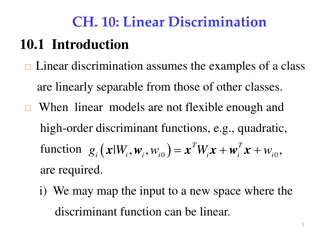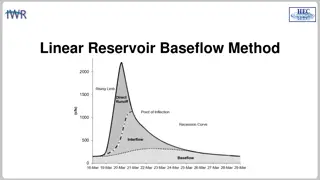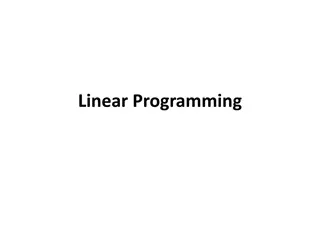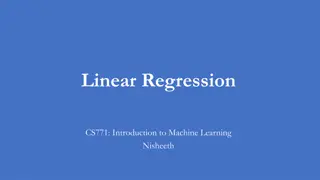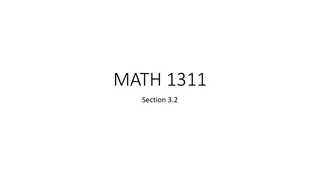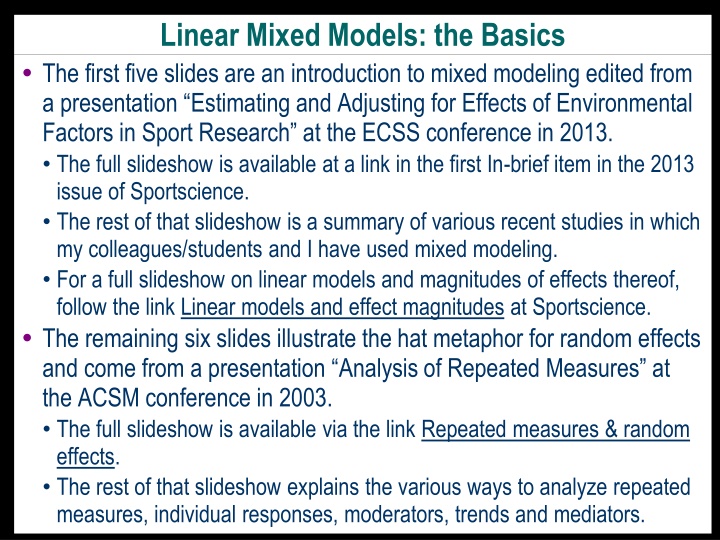
Linear Mixed Models in Sport Research
Explore the basics of linear mixed models in sport research presentations, learning about modeling effects, interaction adjustments, and the distinction between random and fixed effects for data analysis in sports science.
Uploaded on | 2 Views
Download Presentation

Please find below an Image/Link to download the presentation.
The content on the website is provided AS IS for your information and personal use only. It may not be sold, licensed, or shared on other websites without obtaining consent from the author. If you encounter any issues during the download, it is possible that the publisher has removed the file from their server.
You are allowed to download the files provided on this website for personal or commercial use, subject to the condition that they are used lawfully. All files are the property of their respective owners.
The content on the website is provided AS IS for your information and personal use only. It may not be sold, licensed, or shared on other websites without obtaining consent from the author.
E N D
Presentation Transcript
Linear Mixed Models: the Basics The first five slides are an introduction to mixed modeling edited from a presentation Estimating and Adjusting for Effects of Environmental Factors in Sport Research at the ECSS conference in 2013. The full slideshow is available at a link in the first In-brief item in the 2013 issue of Sportscience. The rest of that slideshow is a summary of various recent studies in which my colleagues/students and I have used mixed modeling. For a full slideshow on linear models and magnitudes of effects thereof, follow the link Linear models and effect magnitudes at Sportscience. The remaining six slides illustrate the hat metaphor for random effects and come from a presentation Analysis of Repeated Measures at the ACSM conference in 2003. The full slideshow is available via the link Repeated measures & random effects. The rest of that slideshow explains the various ways to analyze repeated measures, individual responses, moderators, trends and mediators.
The Linear Mixed Model: a Very Short Introduction Will Hopkins Sportscience 14, 49-57, 2010 MSSE 41, 3-12, 2009 Linear = Additive Almost all analyses are based on a model or equation consisting of predictor or independent variables (X1, X 2, ) added together to predict a dependent variable (Y): Y = a + bX1+ cX2+ + error. These models are all just various forms of multiple linear regression. Each X has values for something (e.g., temperature in C), or is a "dummy" variable with values of 0 or 1 to represent absence or presence of something (e.g., venue: not indoors=0, indoors=1). Something with more than two levels (e.g., snow: spring, granular, compact ) is represented by more than one dummy X. The effect of X1on Y is the value of the parameter or coefficient b. The unit of the effect is difference in Y per difference in X1. So, for a dummy X, the unit is difference in Y when whatever X represents (e.g., indoors) is present.
You can have interactions to allow X1 to have an effect that depends on X2 (and vice versa): Y = a + bX1 + cX2 + dX1*X2. You can generate X1*X2 as another variable X12, say, simply by multiplying X1 by X2 in your dataset: if X1=2 and X2=3, X12=6. If X1=X2, you get a quadratic effect of X: Y = a + bX + cX2. Again, you can generate Xsq yourself: if X=3, Xsq=9, etc. Adjusting for Something This fantastic feature arises from the additive nature of linear models. If Y = a + bX1 + cX2, the only possible interpretation of b is that it is the change in Y per change in X1when X2 and any other predictors in the model are held constant. We also say b is the pureeffect of X1 on Y, or the effect of X1 controlled or adjusted for all other predictors in the model. Ditto for all the other predictors in the model: each parameter is the pure effect of its predictor.
So, if the other predictors include the identities of the athletes ( each included as a dummy variable: 300 athletes means 300 dummies!) you can estimate the pure effect of each environmental condition, as if it were all for the same athletes, and parameters for the athletes allow you to estimate pure differences or changes for athletes, as if they were all in the same environment. Wow! Yes, but athlete identities are different from other predictors Random and Fixed Effects The athletes represent a sample from some population, so you get different identities if you repeat the study with a different sample. The variation of athlete identities from sample to sample is random. Hence athlete identity is a random effect. But the identities of snow condition don't change from one sample to another. The identities are fixed, at whatever levels you choose. Hence snow condition is a fixed effect. A mix of fixed and random effects is thus a mixedmodel. Other names for mixed models: hierarchical or multilevel.
More fascinating facts about fixed and random effects A numeric predictor like temperature is fixed, because everyone gets the same parameter: the coefficient is fixed, not the variable! A predictor like race identity can be random, if it s considered as a sample. You can include interactions between athlete identities and fixed effects to get unique effects for each athlete. With a subject random effect, subjects are held constant , so all effects are effectively within-subject changes, apart from the obvious between-subject group effects. The analysis is equivalent to paired t tests. Without the subject random effect, the analysis would be equivalent to less powerful unpaired t tests. Here's another useful way to think about fixed and random effects With fixed effects we estimate andaccount for means, differences between means, or the mean effect of differences in a numeric predictor. With random effects, we can still estimate the individual means (e.g., for each athlete), but we really account for variation, and we summarize it as a standard deviation.
The residual error (the differences between observed and predicted values) is a random effect. You can have different residual SD for different clusters of data between or within athletes. Example: more error when athletes are younger. You can use a spreadsheet or ANOVA-type analyses to take into account random effects in some straightforward models. My controlled-trial spreadsheet does correct estimation of individual responses and their confidence limits. But sophisticated models and large datasets need a stats package that supports mixed modeling: SAS, SPSS, R, Dummy coding is automatic, but you should learn to include dummies yourself for special models. Example: in a study of effects of caffeine on time trials and competitions of an elite swimming squad, we used dummies to code competitions (vs time trials), evening (vs morning) performances, real (vs placebo) caffeine
Analysis of Controlled Trials by Mixed Modeling Data are in the long form of one row per subject per trial: Analysis is via maximizing the likelihood of observed values rather than ANOVA's approach of minimizing error variance. You investigate fixed effects: Trial, if there's only one group. Group Trial, if there is more than one group. You also specify and estimate random effects. "Mixed" = fixed + random. Some mixed models are also known as hierarchical models. Girl Ann Ann Ann Bev Bev Bev Group Trial exptal exptal exptal post exptal exptal exptal post Y 58 62 68 45 . 57 pre mid pre mid Lyn Lyn control control mid pre 39 42 Missing value means loss of only one trial for the subject.
Basics: Fixed Effects Fixed effects are differences or changes in the dependent variable that you attribute to a predictor (independent) variable. They are usually the focus of our research. Their value is the same (fixed) for everyone in a group. They have magnitudes represented by differences or changes in means. Example of difference in means: girls' performance = 48 boys' performance = 56 so effect of sex (maleness) on performance = 56 48 = 8. Example of change in a mean: girls' performance in pretest = 48 girls' performance after a steroid = 56 so effect of the steroid on girls' performance = 56 48 = 8.
Basics: Random Effects Random effects have values that vary randomly within and/or between individuals or settings treated as random samples. They provide confidence limits or p values for the fixed effects. They provide valuable information about differences between subjects or settings and variability within subjects or settings. The individual values of a random effect are processed as a variance and summarized or interpreted as a between-subject or within-subject standard deviation (SD). Examples of a between-subject SD: Differences in ability: SD of girls' performance (Y) = 9.2 Individual responses: SD of effect of a steroid on Y = 5.0, so you can say the effect of the steroid is 8.0 5.0 (mean SD). Example of a within-subject SD: Error of measurement: SD of any girl's Y in repeated tests = 2.0
Basics: The "Hats" Metaphor for Random Effects When you measure something, it's like adding together numbers drawn from several hats. Each hat holds a zillion pieces of paper, each with a number. The numbers have mean = 0, SD = ?? Example: measure a girl's performance several times. Suppose the true mean performance of all girls = 48.3 units. The girl's true performance (not observed) in Trial #1 + The girl's observedperformance in Trial #2 + -1.3 =54.4 48.3+ =55.7 55.7 +2.1 =57.8 55.7 +7.4 The random effects in SAS are Girl and Girl Trial (= the residuals). SD = 9.2 SD = 2.0 Girl* Girl
Basics: Hats plus a Fixed Effect Example: give steroid with a fixed effect of 8.0 between Trials #1 and #2, and measure several girls. Performance in Trial #1 Performance in Trial #2 -1.3 + Ann 55.7+ +2.1 =57.8 55.7+ 8.0=62.4 + Bev 48.4 -3.1 =45.3 + 48.4 +0.7 + =57.1 8.0 + Cas 65.2 -2.8 =62.4 + 65.2 -1.4 + =71.8 8.0 SD = 2.0 Girl* Girl*SD = 2.0 Girl* SD = 2.0 Girl* SD = 2.0 + Deb 40.7 +0.5 =41.2 + 40.7 +2.8 + =51.5 8.0 Girl hat not shown. These are all we can observe. The stats program uses them to estimate the fixed and random effects.
Basics: A Hat for Individual Responses Example: different responses to the steroid. Performance in Trial #1 Performance in Trial #2 8.0+ +5.2 -1.3 + Ann 55.7+ +2.1 =57.8 55.7+ =67.6 + -0.5 + Bev 48.4 -3.1 =45.3 + 48.4 +0.7 + =56.6 8.0 + +6.2 + Cas 65.2 -2.8 =62.4 + 65.2 -1.4 + SD = 5.0 =78.0 =48.8 8.0 SD = 2.0 Individ R es p on s es Individ R es pons es Individ R es p on s es Individ R es p on s es Girl* Girl*SD = 2.0 Girl*SD = 2.0 Girl* + -2.7 + Deb 40.7 +0.5 =41.2 + 40.7 +2.8 + 8.0 SD = 5.0 SD = 5.0 SD = 2.0 SD = 5.0 To estimate the SD for individual responses, you need a control group or an extra trial for the treatment group.


